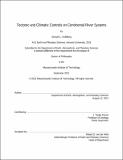| dc.description.abstract | Erosion by rivers is the dominant driver of topographic change over much of Earth’s terrestrial surface, and sets the pace of change for other landscape processes. In this thesis, I explore the complexities of landscapes evolving under fluvial processes. I address questions of how rivers respond to climate, geologic substrate, and tectonics across scales, how landscape disequilibrium results from changing tectonic and climatic forces, and implications of landscape evolution for past human settlement. In the first chapter, I use a process model of river erosion that includes sediment transport feedbacks to show that climate controls the degree to which rock type affects erosion through transport limitations, with arid regions showing a much weaker dependence on rock type than humid regions. This complexity is not captured by typical models of river erosion. In the second chapter, I study the unusual case of the Rio Casiquiare, an ongoing river capture of the Amazon River from the Rio Orinoco. I use this case study to show that large lowland rivers with slope asymmetry across drainage divides reorganize their planform geometry towards a more equilibrated state, and in doing so can create perennial interbasin connections for centuries or longer. In the third chapter, I show that large lowland Amazon rivers have been quickly responsive to cyclical Quaternary climate changes, and as a result have repeatedly incised and aggraded with successive wettings and dryings of the region. In the fourth chapter, I use remote-sensing imagery and machine-learning classification to identify spatial patterns and distributions of ancient settlements, and find that they are almost universally located at the bluff edge at the interface between uplands and floodplains; this is an example of the ways in which geologic and environmental history can influence human society. These studies advance our knowledge of landscape evolution towards a more realistic understanding of the complexities of the natural world and its constant change. | |
